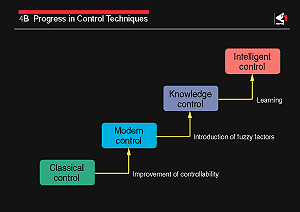The figure shows the stages of
evolution in control theory. Control theory dates from 1868,
when Maxwell made a theoretical analysis of the functions of
a speed governor used to maintain a constant rotational speed
in steam engines. Classical control theory was refined in the
1940s and 1950s, and is based on a mathematical model which gives
the relationship between the input and output of the process
to be controlled. Classical control theory deals with only one
input and one output. However, control equipment called the
general-purpose PID controller, which permits proportional, integral,
and differential control, has been developed and is used in many
processes and plants.
Subsequently, modern control theory has been developed to handle
multivariable systems with many inputs and outputs. Control
based on classical and modern control theories requires the preparation
of an appropriate mathematical model of the process to be controlled.
If the mathematical model is satisfactory, the expected control
can be obtained in a quantitative way. However, with control
systems involving substantial nonlinearity, there are many parameters
that must be determined by experiment in order to construct the
most appropriate mathematical model. It is thus difficult to
prepare satisfactory mathematical models, and hence the effect
of control is limited. Remarkable progress has been made in
recent years in (i) fuzzy theory, which can handle ambiguity,
(ii) expert systems, which utilize the knowledge of experts,
and (iii) neural networks, which are very effective for pattern
recognition and learning. These methods are called intellectual
information processing techniques and are employed effectively
in various problem-solving systems.
Control theory has developed by adopting these methods, and it
has become clear that the concepts and means of control can be
applied not only to manufacturing products, but also to all problems
related to human activities, products, and information, such
as production planning, inventory, and material distribution.
Control theory was first applied by the steel industry to control
one machine/device, and then to control a manufacturing line
and process involving multiple connected devices. Such theory
is now applied in the optimization of the operation of a whole
steel works incorporating many lines. Moreover, control theory
is already applied to some extent in total optimization of company
performance, including logistics, production, and sales activities. |
|
 |
 |
 |
|
|